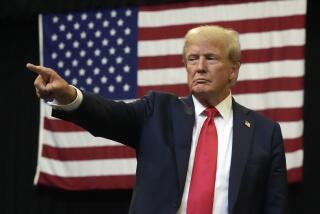Obama confronts an uncertain future on trade with the likely death of his signature TPP deal
- Share via
Reporting from LIMA, Peru — An atypical alliance between President Obama and pro-business Republicans built momentum for the largest global trade agreement in history. Now, the equally unlikely pairing of President-elect Donald Trump and key constituencies of the left are celebrating its near-certain demise.
The debate over the Trans-Pacific Partnership, the accord among the U.S. and 11 other Pacific Rim economic powers, has turned from whether it will be put in place to the question of what the apparent political realignment means for the future of trade.
The pact, the product of nearly a decade of negotiations, was a centerpiece of Obama’s Asia rebalance strategy, designed to open new markets in fast-growing economies such as Vietnam for U.S. goods and expand the U.S. footprint in Asia as a check to growing Chinese influence in the region. Opponents said its labor protections fell short, and Trump campaigned as an opponent of the deal.
“Trade per se is not a bad thing; it’s definitely a good thing,” said Jeffrey Sachs, a progressive economist who was a critic of the agreement. “I hope that the defeat of TPP doesn’t spill over into an open season on trade, because we’d end up losing a tremendous amount.”
Though its passage was hardly assured if Hillary Clinton had won the election — she, too, had come out against TPP amid an unexpectedly tough primary challenge from the more liberal Bernie Sanders — Obama had expected to arrive here for the Asia-Pacific Economic Cooperation summit with a plausible case to make for the U.S. agreeing to the deal. Negotiations between his administration and key Republican holdouts had advanced to the point where backers felt that a vote in the lame-duck session of Congress to approve the deal was within reach.
Instead, the election of Trump forced Obama to explain privately to Asian leaders here what the election result portends for TPP while publicly making his best pitch to Trump not to scrap it. Obama made no explicit mention of the trade pact publicly during a photo opportunity before his meeting with the heads of partner nations, saying only that he looked forward to discussing how to make sure they are “creating more jobs, more opportunity and greater prosperity for all of our countries.”
Trump has been silent about his precise plans on trade since his victory, though his views were consistent throughout the campaign.
“The Trans-Pacific Partnership is another disaster done and pushed by special interests who want to rape our country,” Trump said in a major economic speech in June. “It’s a harsh word, but it’s true.”
In an October speech outlining plans for his first 100 days in office, Trump also said he would immediately announce the U.S. withdrawal from TPP as well as his intention to renegotiate the North American Free Trade Agreement.
The president and president-elect discussed the trade agreement during their 90-minute postelection meeting, but whether Obama appealed to him directly to preserve TPP wasn’t clear.
In a briefing with reporters Friday before the president’s arrival, U.S. Trade Representative Michael Froman said the future of TPP was up to legislative leaders in Congress, and warned that U.S. inaction “poses serious costs” to both the domestic economy and U.S. credibility in Asia.
Scuttling the accord was an invitation to China to take our place, Froman said, as the Asian giant is pursuing its own regional trade accord, called the Regional Comprehensive Economic Partnership, or RCEP.
“TPP is obviously not the only game in town,” he said. “We see people around the table here right now talking about [how] if TPP doesn’t move forward, then they’re going to have to put their eggs in an RCEP basket.”
Froman said he was not speaking for Trump and the incoming administration at the summit and was encouraging partner nations to talk to Trump’s administration directly. Already, Japanese Prime Minister Shinzo Abe has met with Trump to discuss military and economic cooperation. Ratification of TPP by the U.S. and Japan would be essential to ensuring the agreement takes effect.
This week, progressive groups that rallied opposition to TPP sought to claim that it was their efforts, not Trump’s positioning, that helped sink the agreement. But even as they continued to argue that its provisions did not go far enough to protect American workers, they openly fretted that a Trump administration might negotiate new agreements that would be even worse.
Thea Lee, deputy chief of staff for the AFL-CIO and its chief international economist, acknowledged that a progressive model for trade “hasn’t been clearly delineated,” and said the challenge ahead is to discuss next steps with the Trump administration.
“Stopping TPP is only one small piece of what we need to do together,” she said. “This isn’t about being anti-trade or being anti-globalization. It’s about rejecting the model of globalization that our government, both Democratic and Republican administrations, have been putting forward.”
The Obama administration has been careful not to say TPP was dead, and some officials remained hopeful Trump could warm to the agreement. His vice president-elect, Mike Pence, was once an enthusiastic backer of the accord, and Senate Majority Leader Mitch McConnell (R-Ky.) and House Speaker Paul D. Ryan (R-Wis.) had at least supported the concept, if not the final deal.
Rep. Kevin Brady (R-Texas), chairman of the House Ways and Means Committee and one of the chief boosters of TPP in Congress, said he hopes that Trump “allows us to make the case” for the accord, and noted that the trade authority measure passed by Congress in 2015 gives the president-elect the kind of enforcement powers he has argued for.
“Donald Trump was elected to get this economy moving again,” Brady said at an event hosted by Politico after the election. “Finding new customers for American goods and services are a big part of our economic growth. Trade is what provides that opportunity.”
For more 2016 campaign coverage, follow @mikememoli on Twitter
ALSO
Donald Trump’s first picks for top jobs show how he plans to govern from the hard right
‘There’s nothing wrong with being white.’ Trump’s win brings ‘white pride’ out of the shadows
White nationalists’ ‘man in the White House’? Bannon appointment provokes angry rebukes
More to Read
Get the L.A. Times Politics newsletter
Deeply reported insights into legislation, politics and policy from Sacramento, Washington and beyond. In your inbox three times per week.
You may occasionally receive promotional content from the Los Angeles Times.










